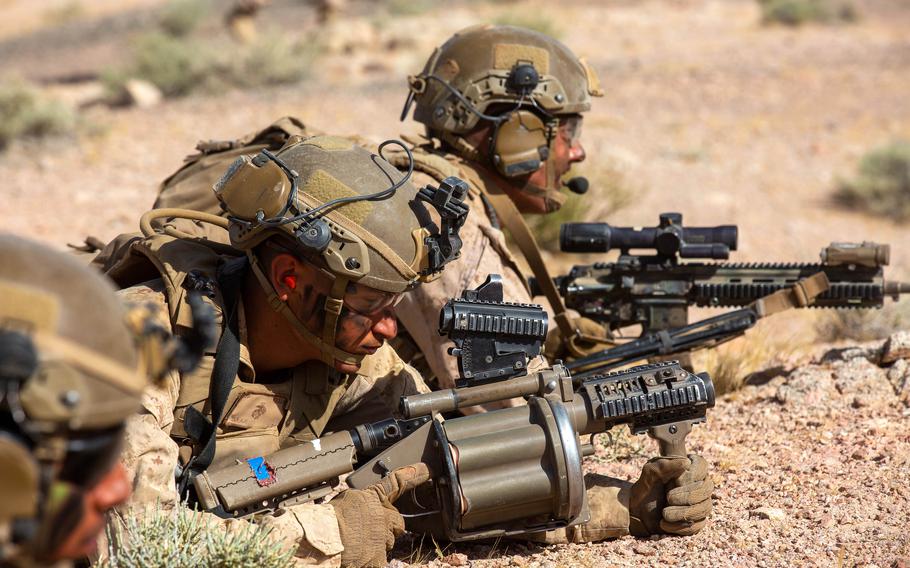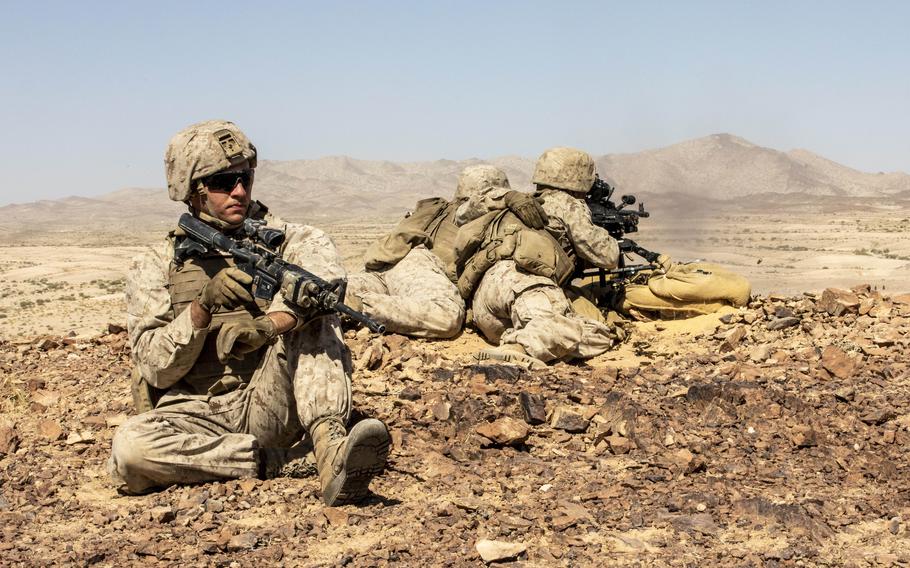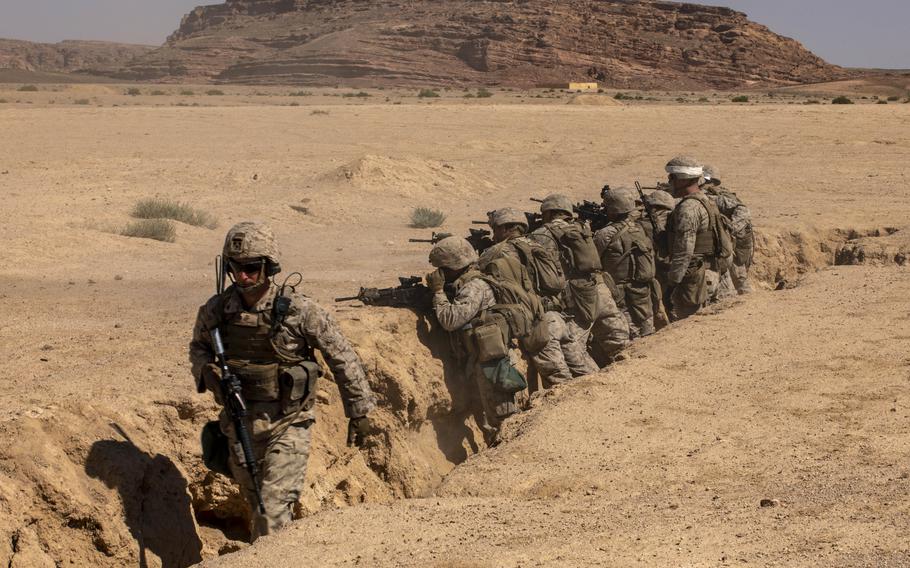
A Marine with 2nd Battalion, 5th Marines, 1st Marine Division prepares a grenade launcher during exercise Intrepid Maven on July 13, 2023 in Jordan. ( Khalil Brown/U.S. Marine Corps)
Marine Corps deployments to the Middle East won’t look like the ones the service became known for during recent decades of war, the top Marine general in the region said in a recent interview.
In lieu of the resource-intensive, multi-month tours that characterized the Iraq and Afghanistan wars, the Marines are going with smaller “episodic deployments,” said Maj. Gen. Paul Rock, head of Marine Corps Forces Central Command.
“We’ve adapted the way that we do business,” Rock said.
The missions would deploy U.S.-based Marines for short-term tours to support a specific need, Rock said.
Rock referred to a recent short-notice deployment of 17 Marines from the North Carolina-based 26th Marine Expeditionary Unit to Kuwait this spring as an example.
The Marines brought to the Middle East the L-MADIS counter-unmanned aerial system platform, known for knocking an Iranian drone out of the sky in 2019, Rock said, confirming a previously unreported detail of the deployment.

U.S. Marines take part in the Intrepid Maven exercise July 5, 2023, in Jordan. For now, the Marine Corps is likely to maintain a small presence in the Middle East augmented by short deployments. ( Jonah White/U.S. Marine Corps)
They came under the tactical control of the Army’s Area Support Group Kuwait, which supplied them over the course of their 30-day tour, Lt. Col. L.L. Gilbert, a MARCENT spokesman, said last week.
The Marines and Central Command are having to maintain their missions with fewer troops and dollars as the U.S. focuses on potential threats from China and Russia.
With fewer resources in the Middle East, the Marines will have to partner more with other services for logistics and supply, said Joslyn Fleming, a defense policy researcher at the Rand Corp. and a Marine Reserve lieutenant colonel.
“What CENTCOM is having to grapple with is a lot of resource constraints,” Fleming said.
MARCENT recently had as many as 2,200 Marines assigned to it, Defense One reported in 2022. That number is down to about 200, said Gilbert, adding that troop strength increases during training exercises.
In making up for their smaller numbers, the Marines say they are now working more closely with the Navy in particular.
That’s in line with changes the service is making worldwide, Rock said.
In 2020, a redesign of the service was announced. The transformation was expected to be completed by 2030, with the aim of readying the service for potential conflict with larger adversaries like China or Russia.
While two decades of wars in the Middle East brought the Marines into land conflicts, the so-called Force Design 2030 seeks to emphasize the Corps’ roots at sea.
The region is “fundamentally a maritime theater” due to the presence of key waterways such as the Suez Canal, the Strait of Hormuz and the Bab-al-Mandeb, Rock said.

Marines maneuver through trenches in Jordan on July 13, 2023, during exercise Intrepid Maven. Small force numbers are likely to be the norm for the Marine Corps in the Middle East as it takes a new tack in the region after the wars in Iraq and Afghanistan. ( Jonah White/U.S. Marine Corps)
The Marine presence flying over those waters now includes MQ-9 Reaper drones, Rock said, adding that that the service is practicing long-range aerial targeting.
The Marines also are part of the increased rotation of U.S. forces in the Strait of Hormuz amid recent tensions between the U.S. and Iran, Rock said.
While the closer ties with the Navy in the Middle East and elsewhere generally haven’t raised concerns among former Marines and analysts, the leaner approach of the emerging force design has had its critics.
Overall, the project eliminates tanks as well as some artillery and aviation assets, while reducing the number of Marines by 12,000.
Richard Mills, a retired Marine lieutenant general who once commanded 20,000 Marines in Afghanistan from 2009 to 2011, said he’s surprised at how few troops MARCENT has now.
It’s good that the Corps has improved at launching drones and shooting down missiles, but there’s a risk that downsizing could sacrifice the Marines’ ability to rapidly deploy, Mills said.
“We are relying on the other services to provide some of the vital things that we used to provide,” Mills said in a phone interview.
Some of those skills are still being practiced, if on a relatively small scale.
Rock cited missions such as the Intrepid Maven exercises, which began in 2021.
The most recent example of the drills ended last week and paired 450 U.S. Marines and sailors with the Jordanian armed forces.
“Every one of these events provides a great learning opportunity, which has direct applicability, to the service’s capability and capacity to respond and deploy forces in a crisis response or contingency war plan scenario,” Rock said.